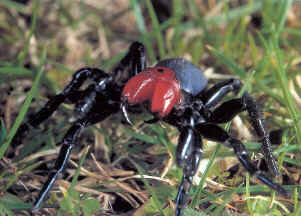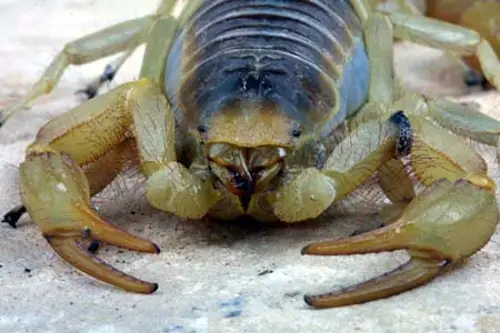Black Widow
Famous, or infamous for its neurotoxin injecting bite, the Black Widow is not by definition an aggressive spider.
A member of the family known as arachnids, the black widow is most common in areas where the climate remains temperate year round, and are particularly prolific in Arizona and New Mexico.
There are three types of Black widows, surnamed Southern, Northern and Western Black widows, respectively.

Black Window Spider
Female Black widows are highly glossy and black in color with a red marking in the shape of an hourglass on the underside of its belly.
A black widow may range in size from about 1 ½ to 2 inches for the females, to about half that size for the males. They have long spindly legs and a small abdomen in relation to their overall size. Males are usually dark brown in color with some striping or dots, but they do not have the distinctive hourglass shape..
The coloration of the Black Widow is a warning beacon as it is with many other toxic insects. They are not edible to birds however will not usually kill them if they are eaten.
Males, which are markedly less venomous than females are sometimes eaten by prey, however they can still cause some ill effects in some cases.
Black Widows will eat a large variety of prey insects, and usually trap it by the use of a web, as do many other spiders.
When the other insect has become hopelessly tangled within the sticky surface of the web the black widow will enter the net and wrap the insect tightly within its web, which is remarkably strong.
The spider will then bite the prey insect and wait the approximately ten minues for the venom to do its work. Only when all action from the prey stops does the spider carry it back into a corner retreat before it begins to feed.
Black widows will mate at nearly any time of year. When the male spider is mature enough to breed he will spin a web and leave semen on it. He will then charge himself with the sperm and using a body part known as a palpi, will deposit the sperm within the females body opening.
She will then lay eggs in a container of spider silk where they will be actively guarded.
Female Black Widows can make up to ten egg sacs in a years time, each holding about 300 eggs, although the number can be more or less.
It takes about 30 days for the eggs to hatch. It is a very rare occurrence that more than a quarter of the eggs will survive. Many will fall victim to the cannibalistic tendencies of their siblings.
A female black widow lives for rather a long time for spiders, up to as long as five years. The males lifespan is far shorter than this, but not for the reasons most people might imagine.
Unlike many of their counterparts in the spider kingdom, the female does not always eat the male after mating. In fact this happens only rarely.Find out more about the Black Widow over at Wikipedia »



i had a question, is there only one type of black widow? Becaue i seen a black widow that was all brown w/ black and it had an redish orange hourglass.
yes there are differtent types.about 20 types.
Hi, i’ve found a spider nest in my garden, and a little concerned as i cannot find the type it is – a little worried it may be a male black widow! I have a child that’s in the garden often, and i’ve taken a picture of it if this will help. Could you please help me to identify what kind of spider it is and if it’s venomous?
Thanks
hi, male black widows are harmless, so if that’s what it is, you have nothing to worry about.
heyyy they r they can bite through ur shoe if you can stand on it and they r very very pain full if you get bitten by it xxx
heyyy they r they can bite through ur shoe if you can stand on it and they r very very pain full if you get bitten by it xxx
I saw one at the Alligator Farm in St.Augusting in a tree when we were eating lunch for a school field trip.I also saw two poisonous catapillers.
What is the name of the tree that Black Widow Spiders just love to hang out in? Someone said it was a Sasafrass. Is this true?